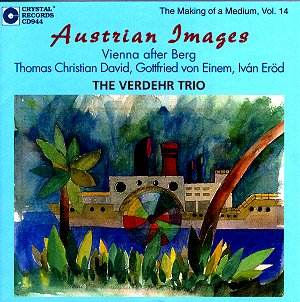Of the three Austrian composers represented here,
Thomas Christian David (the son of the composer Johann Nepomuk
David) has most consistently composed works for the Verdehr Trio.
Besides the three trios recorded here, he has also written a Duo
for violin and clarinet, a Triple Concerto
(on Crystal CD 745), Carmen Suite and Sinfonia
Concertante for trio and wind orchestra (both on Crystal
CD 749). Davidís three trios are roughly conceived along the same
lines, the fairly traditional fast-slow-fast pattern, although
Trio No.3 "Aziz Djoune" reverses the order
starting with a Vivace and ending with a moderately fast
movement. Trio No.1 (1978) and Trio No.2
(1989) are similar in outlook, although the Second Trio is more
tightly argued than its divertimento-like predecessor. The more
recent Trio No.3 "Aziz Djoune" is partly
based on a love song from Iran. The composer insists that the
music here should be played with the most vivid tonal colours,
sometimes echoing playing techniques associated with folk music.
Hungarian-born Ivan Eröd studied in Budapest
with Pál Kadosa and Ferenc Szabó before emigrating
to Austria where he continued his studies, among others, with
Hans Jelinek and where he now resides. His music is clearly indebted
to the Austrian tradition of the so-called Second Viennese School,
though it is not strictly or dogmatically dodecaphonic or serial.
Though in two movements, Erödís Trio Op.59
is a theme and variations of sorts. The second movement explores
most of the contrasted material stated in the first movement in
an attempt to bring its disparate elements into a more unified
whole.
Gottfried von Einem is probably the most familiar
name here, although his music may not be all that familiar.
However it has been championed by some distinguished conductors
such as Ferenc Fricsay who conducted the first performances of
von Einemís first opera Dantonís Tod and who recorded
some of his orchestral music during the LP era (some of these
recordings have now been re-issued in CD format). His Verdehr-Trio
Op.97 of 1992 is in four concise and contrasting movements
in which "melodic lines and chords should be able to give
composer and listener joy and stimulation clarity of spirit"
(the composerís words). Uncomplicated, attractive music characterises
this lovely, unpretentious and entertaining work.
This is Volume 14 of Crystalís pioneering series
The Making of a Medium; no mean achievement which says
much for the artistry and the musicality of the Verdehr Trio.
They have tirelessly encouraged composers to compose music for
them, with often very satisfying results. Again, unfamiliar, though
worthwhile works in clean and affectionate readings. There is
much to enjoy here.
Hubert Culot

![]() Verdehr Trio (Walter
Verdehr, violin; Elsa Ludewig-Verdehr, clarinet; Silvia Roederer, pianoa;
Gary Kirkpatrick, pianob)
Verdehr Trio (Walter
Verdehr, violin; Elsa Ludewig-Verdehr, clarinet; Silvia Roederer, pianoa;
Gary Kirkpatrick, pianob) ![]() CRYSTAL RECORDS CD 944
[74:30]
CRYSTAL RECORDS CD 944
[74:30]